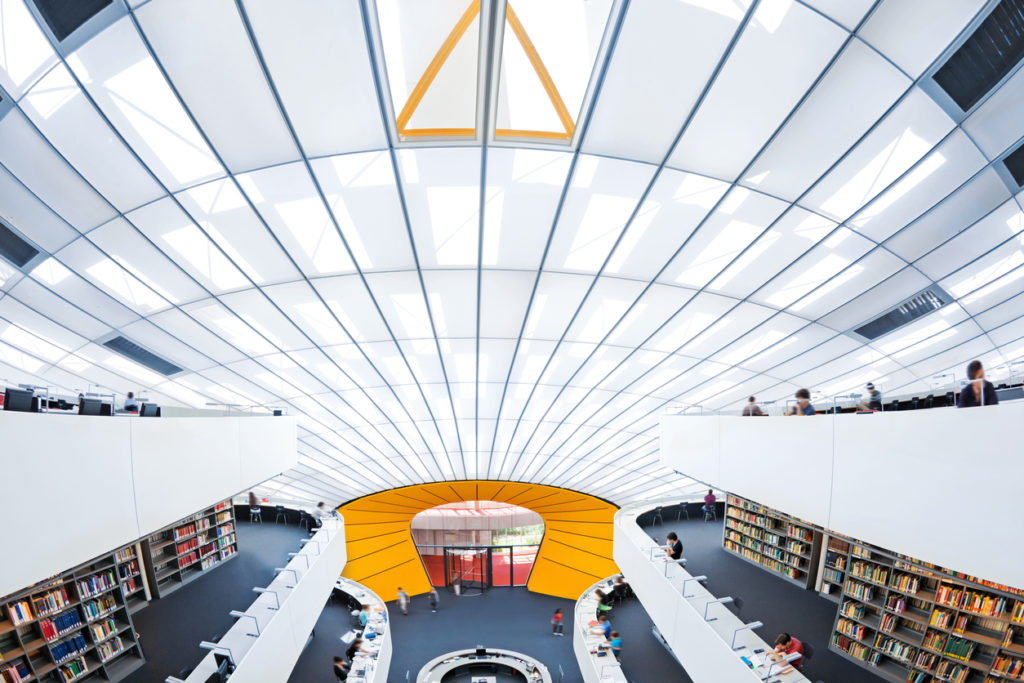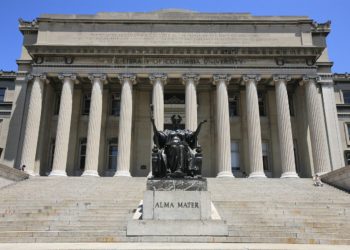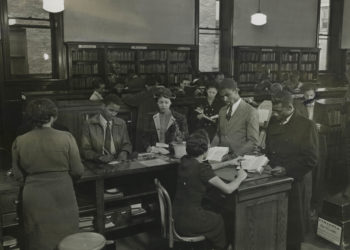Editor’s Note: Today’s post is by Lynn Silipigni Connaway, Ixchel M. Faniel, Brittany Brannon, Brooke Doyle, and Brian Lavoie. Lynn is the Director of Library Trends and User Research at OCLC Research. Ixchel is a Senior Research Scientist at OCLC Research. Brittany is Research Support Specialist at OCLC Research. Brooke is a Senior Project Coordinator at OCLC splitting her time between the Library Trends and User Research and WebJunction. Brian is a Senior Research Scientist with OCLC.
The pandemic has created a ripple effect – a stone thrown into the library pond – that is re-shaping the work, collections, and engagement experiences in libraries. In turn, changes to these experiences have been rippling out to communities and organizations that libraries have relationships with, like publishers, other agencies, institutions, community members and groups, and system providers. But of course, the ripples work both ways. As these communities and organizations make their own changes and adaptations, new ripple effects have developed that must also be absorbed by all.
The pandemic initiated or accelerated changes that often were executed in haste and with acknowledged and understandable imperfections. While we all continue to manage life with the pandemic, it is time to reflect on the changes that were made and assess which ones were effective. For library leaders, that means strategically transforming the library to adapt to evolving staff and community needs and expectations — moving toward a New Model Library.

Twenty-nine leaders representing academic (community college, technical, baccalaureate, and research) and public libraries located in urban, suburban, and rural areas across the globe were interviewed by the OCLC Research team from April to July 2020. These leaders discussed the changes to library work, collections, and engagement experiences that they believe will continue and what their visions are for the future of libraries.
For some libraries, many of these changes were already underway before the pandemic, but for others, they are new. Although some of the actions taken by leaders can be adopted by others, a New Model Library is developed to meet the needs of the specific community and mission of that library and its parent organization. A New Model Library is not solely about sustaining changes brought on by the pandemic or trying to do what other libraries are doing. Instead, it’s about taking a step back to see the bigger picture of the trends that impact all of us, and strategically choosing a way forward that helps to create the future your community needs.
In this post, we discuss some of the findings from these conversations. For more detail about the findings from this research, see the OCLC Research briefing, New Model Library: Pandemic Effects and Library Directions.
Work Experiences
“Yeah, the staff has thanked me several times for being aware of their feelings and emotions and not just moving forward like a steamroller, but still moving forward.” (Urban Public, US)
Has the pandemic initiated or accelerated changes in how you communicate with staff? How have staff’s expectations about flexible work options changed?
As an example of the challenges inherent in work flexibility, an academic library leader in the US described staff members who did not have home internet and were relying on hotspots to work remotely. The leader also explained that there only was one VPN connection for the department, which limited remote staff’s access to the ILS. Leaders need to be aware of and address evolving staff needs as work experiences change.
While there is no single way to address work experiences, library leaders emphasized the need to:
- Focus on staff well-being. The emotional toll on staff should not be underestimated. Ensuring that staff have the time and resources to tend to their well-being will be essential. As leaders continue to manage change, it will be important to continue to communicate with staff frequently and clearly as well as seek their feedback and support.
- Challenge traditional divisions of labor. As staff collaborated and depended on each other for professional development and cross training, they were able to be agile and respond to changing community needs. As collection and engagement experiences evolve, job descriptions and organizational structures will be reimagined and workloads rebalanced to ensure that staff are positioned to succeed in meeting community needs.
- Train for the future. Leaders must commit to continuous learning and professional development while ensuring that all staff, whether on-site or remote, have access to training time and resources including IT support to be prepared for work in a New Model Library.
- Embrace work flexibility. Leaders learned that staff who work remotely are as productive as their colleagues working in a library location, providing incentive for creating more flexible work arrangements in a New Model Library.
Some recommendations to consider:
- Use the best practices from the business community and associated disciplines to develop and manage organizational change.
- Have staff work on the teams where they are needed at the time instead of being assigned to one team with one mission and purpose.
- Learn how to be attuned to one’s own and others’ mental and emotional states as well as how to support well-being in the work environment.
Collection Experiences
“And they [faculty] still quite like the serendipity of browsing a shelf and something hopping out to them. And that way of behaving isn’t replicable in the digital world in quite the same way…it has just highlighted how ungenerous…discovery systems are and wanting to find a more generous open way in which we can make content discoverable…” (Research University, Europe)
Have community expectations for content and collections changed? Does your collection strategy need to change? The pandemic forced library leaders to find new ways to connect the community with the physical collection, and these transitions were not always easy or smooth.
One leader of a library at a two-year college in the US described how his institution had not done e-reserves prior to the pandemic and had to figure out a quick fix. During the pandemic, students desperately needed access to their textbooks, and the library found some partial solutions, but some students had to work with their professors to figure out individual workarounds for textbook reserves.
As library leaders adapt collections experiences, they stated they intend to:
- Acquire digital and open content strategically:The predominance of digital and open resources during the pandemic highlighted their value and increased their usage, but digital usage models do not replicate print models. Library leaders will need to continue to work with content providers for broader and more affordable access. Many community members also struggled to find and use digital and open content effectively. Library staff must improve the online environment in which discovery and use takes place — for example, by simplifying access to e-resources and open content by finding more ways to integrate digital content into user workflows.
- Prioritize resources that close the digital divide:Many library leaders provided hotspots and loanable devices when community members could no longer access these resources in the library building. A New Model Library will meet community needs for connectivity and software as well as information literacy instruction to combat misinformation and disinformation, and devices that enable virtual engagement with the library’s collections and offerings.
- Create new connections to physical collections:Physical materials continue to be an important and valued part of the library offering. How users connect with these materials is changing. A New Model Library will include the transformation of contactless delivery from a pandemic necessity to a valued convenience. Innovations will allow users to engage directly with physical collections through online environments or allow library staff to browse or otherwise interact with physical collections on behalf of users.
Some recommendations to consider:
- Use video conferencing or augmented reality for the community to browse and engage with physical collections online.
- Expand user-driven acquisition of physical materials so more items can be delivered to homes and offices before being added to the library collection.
- Digitize local resources and support the community in the creation of open content by offering training and providing appropriate technology.
Engagement Experiences
“…I would hope it [the library] would reemerge from this time of isolation as a vital community hub…that libraries are the places we come to talk about what we learned…not as a library, but as a community…And what are our community needs?…who right now is in the most desperation? And we have no knowledge that they are because we’re isolated.” (Urban public, US)
What did the pandemic reveal to you about where and how engagement happens? Did new partnerships emerge that help you engage with your community in a new way or with a new segment of the population?
For example, a library leader in a US community college with five campus libraries only had virtual classes in one library and reference by email, phone or face-to-face. Within a week, they transitioned all five campus libraries with 26 staff to virtual reference and online library classes to engage with the community in new ways.
As library leaders transform engagement experiences, they shared that they intend to:
- Invite engagement in physical spaces. Making spaces more welcoming and inclusive for people to gather requires consideration of all types of community members and how they want and need to use the library. Library space is a service, and it should be clearly communicated to the community and to partners that the availability of various shared, freely available in-person resources, spaces, and materials is a unique part of the library’s value.
- Partner with a purpose. Partnerships must add to the library’s value and meet users’ needs in a way the library cannot alone. Purposeful collaborations are critical to provide programming and physical spaces for the community.
- Lead with a hybrid approach. During the pandemic virtual engagement experiences had mixed success. Even though attendance was high early on, most library staff felt pressure from the community, i.e., administration, staff, faculty, the public, and staff, to reinstitute in-person experiences. Finding the balance between in-person and virtual experiences will be the work of a New Model Library. Successful strategies will utilize the strengths of both physical and virtual experiences by carefully considering community needs, the type of content, and the nature of the engagement.
Some recommendations to consider:
- Create spaces that welcome the use of the library by all. Beyond accessibility, also consider the way that the design of your space invites or inhibits different types of engagement from current and potential users.
- Reexamine use policies with an eye toward facilitating diverse needs within your community.
- Partner with other community agencies and departments to utilize library space and promote programming.
Conclusion
The pandemic required library leaders to plan and implement change with agility — taking quick and innovative action in response to changing circumstances and expectations — and collaboration–working with stakeholders to lead change within libraries, institutions, and communities. A New Model Library requires finding the best balance of virtualization — expanding online library experiences for staff and the community — and space — finding new ways to engage within the physical library — for each library’s community and context. Engage with staff and the community to chart the ripple effects everyone has created and absorbed and map your way forward to a New Model Library.
Our user study research clearly demonstrates that community needs and expectations are based on the situation and the availability, familiarity, trust, and convenience of the offerings. This means that people may want access to library staff for reference consultation and to access collections in both the physical and online environments at different times within their day or at different points in their information process. Hence, there is not one way to provide access to collections and engagement experiences, but different ways. As you continue to plan for the future, it is critical to regularly identify and respond to your community.
Change is not one and done, but an iterative process. It requires determining what is working, what is not, and what can be done to better improve the community’s experiences. With or without the pandemic, the ripple effects will continue, as changes in the library radiate outward to publishers, partners, community members, and system providers, even as changes in those communities ripple back to libraries. For example, both library leaders and content producers and providers are experiencing the need for enhanced discovery systems for finding licensed and open content and collaborative access models for digital resources and are working together to create new discovery and access models.
The New Model Library is not solely about sustaining changes brought on by the pandemic but also about continuing to evolve services or policies that were transforming before the pandemic. As we begin a new year it is a perfect time to pause and reflect. Acknowledge what has been accomplished to maintain and improve library experiences in light of the pandemic. Engage with staff and the community to chart the ripple effects everyone has created and absorbed and map your way forward to a New Model Library.
Consider joining us when we convene library leaders and staff around these topics to share what we’ve learned. It will be a time for us to learn about what’s happening and changing as we move toward a New Model Library.
Discussion
1 Thought on "Guest Post — What’s Your Vision for a New Model Library?"
Such a spot on and insightful read. As the ED of an urban library in a vibrant and diverse community, the possibilities are endless! Please include me in future conversations. I would love to share all we have been doing to think outside the building! http://Www.newburghlibrary.org


